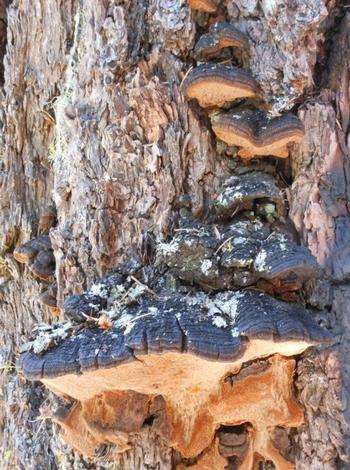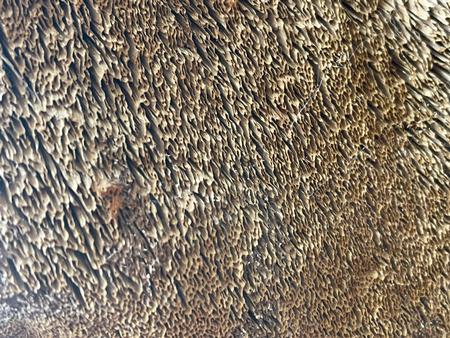Red Ring Rot (Porodaedalea pini)
Trees Affected
Common: Conifers in the family Pinaceae (pines, true firs, Douglas-firs, spruces), but especially Douglas-fir and ponderosa pine
Summary
Red ring rot (Porodaedalea pini) is a widespread wood decay fungus that affects trees in the family Pinaceae. Spores of this fungus typically enter trees through branch stubs in the mid to upper trunk of its host, and subsequently set about decaying heartwood. Early in the decay process, affected heartwood takes on a reddish purple hue. However, as the fungus progresses, this develops into the characteristic spindle-shaped pockets of black-flecked white rot surrounded by sound, reddish wood. Eventually, the fungus acquires enough nutrients to produce fruiting bodies, which are the most noticeable outward sign of this pathogen. Fruiting bodies are tough perennial conks, with reddish brown furrowed tops and golden, irregular pores that give the bottom of the conk a maze-like quality. Conks typically emerge from branch stubs, and may be stacked vertically on top of one another. Red ring rot can cause extensive decay in older trees. Although this may lead to potential hazard trees and less merchantable timber in some contexts, this fungus, like many other heartwood rotters, plays an important role in enhancing forest structural complexity and diversity by increasing the probability of windthrow in old trees and providing habitat for cavity-nesting wildlife. Note that this fungus may also be listed as Phellinus pini or Fomes pini in older records.
Local Distribution
Widespread throughout its native range.
Management Strategies
Red ring rot creates habitat for wildlife and promotes more complex forest structure, so management strategies will vary with land use goals. If the primary objective is to increase diversity and ecological function, doing nothing or actively promoting decay via branch pruning may be beneficial. If the primary objective is to maximize timber yield, avoiding unnecessary branch injury and managing for shorter harvest cycles will likely minimize wood decay. If the primary objective is to maintain public safety, monitoring and removing trees with extensive heartwood decay may be necessary in some areas.
Pests and Pathogens with Similar Symptoms
Porodaedalea cancriformans: This closely related fungus produces clusters of smaller conks that may look similar to those produced by P. pini. However, P. cancriformans is a canker fungus that has only been observed on white fir and occasionally on grand fir.
Ganoderma applanatum: This fungus also decays heartwood and produces a white rot. However, unlike red ring rot, it typically inhabits dead trees. However, it may opportunistically infect heartwood in living trees with exposed heartwood, so its fruiting bodies are occasionally found on live hosts. G. applanatum conks are typically perennial, and much larger than those of red ring rot. Additionally, their pores are small and white, and turn brown (due to brown spores) when touched.
Armillaria Root Disease: This fungus also produces a white rot. However, since Armillaria can attack sapwood, trees with this root disease will also display crown decline, and the fruiting bodies of Armillaria are mushrooms that fruit mostly at the base of the tree.
Further Reading
Additional identification, visuals, and management recommendations:
https://www.fs.usda.gov/Internet/FSE_DOCUMENTS/stelprdb5336983.pdf




